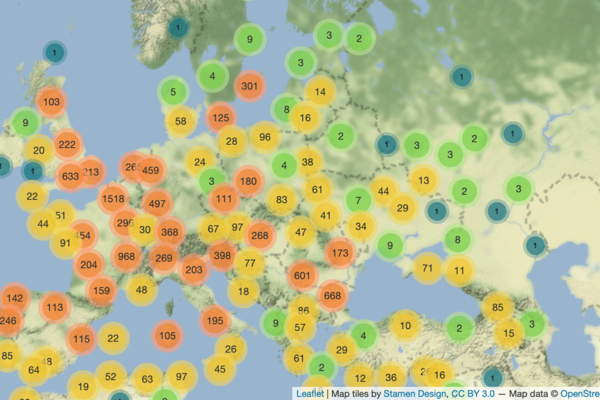Coin Hoards of the Roman Empire
‘Coin hoards of the Roman Empire’ (CHRE) maps and digitises the coin hoards of the Roman Empire through participatory research. This digital conservation initiative is funded by the Augustus Foundation.
About the project

Thousands of Roman coin hoards have been discovered throughout what was once the Roman Empire and beyond. With new hoards discovered every year, the CHRE project has created a comprehensive and accessible online resource to unlock their potential to enhance our understanding of the Roman economy.
The scale and quality of the data offers exceptional opportunities for interdisciplinary research. So far, the project has put online data relating to 13,800 hoards from 72 countries containing 5.8 million coins (November 2022).
The CHRE project documents hoards of all coinages in use in the Roman Empire between 30 BC and AD 400. It also includes Roman hoards found outside the Roman Empire. The project is a joint initiative of the Ashmolean Museum and the Oxford Roman Economy Project.
Further information about the project is on the Roman coins online: global research collaboration page on the Digital collections at Oxford University website.
Outputs
In 2015, the project launched a web app – the Coin Hoards of the Roman Empire online resource, providing a free international platform for multiple users and institutional partners. To date, the project has supported 50 institutions in 25 different countries to put online this aspect of their national heritage, including universities, antiquities authorities, museums, national libraries, national and transnational finds schemes, national banks, and numismatic societies. 20 graduate students have been involved internationally.
Interpretation is promoted by international conferences sponsored by the project and published by Oxford University Press in the series Oxford Studies on the Roman Economy: J. Mairat, A. Wilson, and C. Howgego (eds.), Coin Hoards and Hoarding in the Roman World, 2022.
Impacts
CHRE has enhanced international awareness of imperial hoards which has helped to contribute to their preservation. For example, participation in the project has changed how hoards are perceived in countries such as Israel and Belgium, by making national heritage available to national and international audiences.
In addition, the project has:
- led to the recovery of looted national heritage and smuggled goods in Romania;
- influenced changes to the curation of coins by museum professionals in Germany by allowing museums to link their objects to the hoards from which they came;
- led to the creation of a new Master’s course in numismatics in the Netherlands and been the subject of a Digital Humanities course in the USA;
- linked amateurs and professional archaeologists, community history and transnational history via a display in the Ashmolean Museum and via the project’s Twitter feed; and
- promoted better understanding and therefore better reporting by public.
You can also follow the project on Facebook and Twitter.
The project was submitted as an impact case study to REF 2021; the full impact case study can be downloaded from the REF 2021 impact case study database.
Project team
Professor Chris Howgego, Ashmolean Museum, University of Oxford
Professor Andrew Wilson, Oxford Roman Economy Project, University of Oxford
Dr Cristian Gazdac, University of Cluj-Napoca, Romania
Dr Marguerite Spoerri Butcher, Ashmolean Museum, University of Oxford




